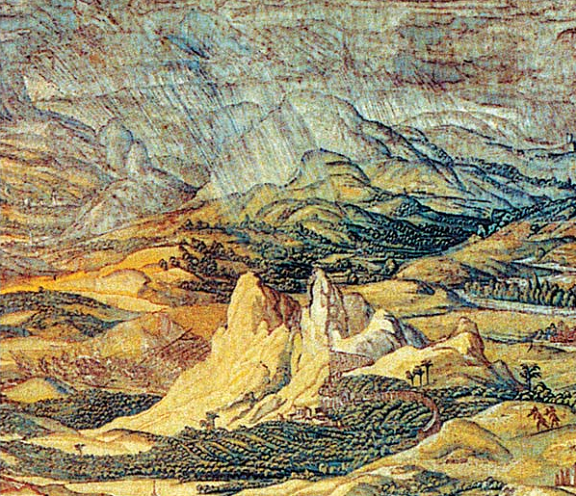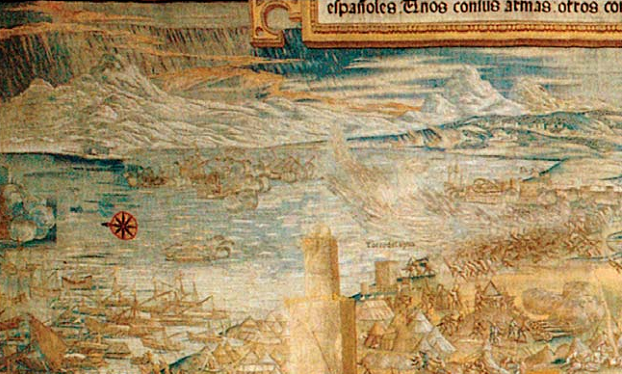Nowadays, everyone knows what a tornado looks like. Any kid can doodle you a rope-shaped or a trombone-shaped one. The characteristic shape is so recognizable, even when simplified to the limit, that it can be easily used in art as a symbol. An elegant example of that can be seen in the Dutch city of Leiden; one of its many wall poems is “Maskoke Okisce” (“A Creek Fable”) by the Creek Indian poet Lois Little Coon Oliver:[1]
So, imagine my surprise, when I found out that tornadoes were virtually unknown to the Western civilisation until the onset of the scientific age. Not a single depiction of a convective atmospheric phenomena (waterspout, whirlwind, dust devil etc.) is known before the 16th century!
The oldest printed one is from a 1587 broadsheet, describing a tornado observed on July 1 that same year in Augsburg, Germany:[2]

Recently, this was antedated by some 40 years in a paper by Klaus Hoinka and Manuel de Castro.[3] There is a very conspicuous slim funnel-shaped cloud in the very center of the first tapestry of the “Conquest of Tunis” series, produced for emperor Charles V by Willem de Pannemaker in 1549-1551 and based on 1546-1550 cartoons by Jan Cornelisz Vermeyen:4

What’s more, the first tapestry also has a depiction of heavy rain, while the fourth has a sandstorm and more rain:


While the sandstorm played a significant role in the campaign and is well documented, there is no mention of a tornado in contemporary documents. Hoinka and de Castro argue that the placement of the funnel next to the important Montserrat monastery (where the attack on Tunis was started), and its connection to massive clouds5 both point to the symbolic use of tornado:
A literature search indicates that the depicted weather phenomena, except the sandstorm, were not recorded during the crusade to Tunis. The tornado and the heavy rain seem to be implemented in order to emphasize symbolically the beginning and ending of the “holy crusade.” The tornado that appears close to the Montserrat mountain indicates God’s blessing of the expedition, which began in Barcelona. The final battle occurred in Tunis where a storm with heavy rain appears on the tapestry. The symbolic interpretation of the storm is that it should be seen as a manifestation of divine anger and punishment of the Muslim corsair Barbarossa. On the other hand, the rain storm could also indicate God’s blessing and approval of the troops who needed rain. Arguments can be made to support both interpretations, and it is not clear that one needs a definitive answer either way, as long as one knows that it has some deeper meaning.
This is in agreement with Cooper (1978), who pointed out that whirlwinds and tornadoes were regarded as a manifestation of energy in nature, rising or descending from a center of power associated with God. The funnel, thus, becomes a vehicle for divinity. Similarly, Cirlot (1988) corroborates this because symbolically “everything that occurs in heaven or descends therefrom, has a sacred quality about it.”
As plausible as it sounds, I have to say I’m not totally convinced. There’s at least two more things this research needs:
- Other examples (written or painted) of tornadoes or something similar, linked to a blessing and not punishment. I searched the relevant literature and couldn’t find any.
- Historical records on tornadoes in the Montserrat area. If it’s possible there was one anywhere nearby, the whole argument crumbles somewhat.
Both these images had only a limited impact. The leaflet was only circulated in Augsburg. The tapestries, although 4 by 7-12 metres (over 100 metres combined!) and occasionally hung on the outside walls of buildings, were only seen by the elite. So, the first image of a tornado to be seen by a wider public was a small drawing of several types of wind from Orbis Pictus[6] by John Amos Comenius (it is also the only 17th century depiction of tornado I know of). The first children’s picture book, Orbis Sensualium Pictus (The Visible World in Pictures) was published in Nuremberg, 1658 in Latin, and in countless places, languages and forms ever since. It is very much a product of its time, and I love it to bits:
A Wind under Ground causeth Earthquake!
References:
- The poem is in Muskogee language and can be roughly translates as “The little children say: the Tornado’s words come from evil spirits that the tail steals from the turtle, and after, they spin quickly round and round to the ground scared to death.”.
- Wegener, A. L., 1917: Wind- und Wasserhosen in Europa (Tornadoes and Waterspouts in Europe). Vieweg und Sohn Verlag, 301 pp. Scans (in German)
- Klaus P. Hoinka, Manuel de Castro “A Renaissance Depiction of a Tornado” (2005) Bull. Amer. Meteor. Soc., 86, 543–552. google scholar
- Vermeyen accompanied Charles V during his 1535 Tunis campaign and brought back a series of preparatory sketches; I know nothing about their fate. The series consisted of 12 cartoons and tapestries, only 10 of each still exist. The first one only exists in tapestry form.
- The clouds in question, by the way, are totally unconvincing. Tornadoes are never associated with fair-weather cumulus.
- 1887 London edition, containing the original 1658 woodcuts and Latin text + the oldest 1659 English translation can be found here. The tornado illustration was identified in: M. Setvák et al “Tornadoes within the Czech Republic: from early medieval chronicles to the internet society”, Atmospheric Research, v. 67-68, 2003, pp. 589-605. (google scholar)

